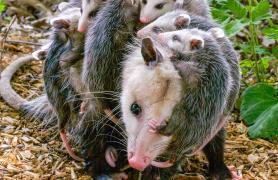Poison ivy grows in every corner of Missouri. It’s found in prairies, forests, fields, and marshes. It may even turn up in your backyard. The plant can grow in a clump like a shrub or climb up trees like a vine.
Leaves of three, leave it be
Each poison ivy leaf is made up of three leaflets. What makes things tricky is that many harmless plants also have leaves with three leaflets. To sort the harmful from the harmless, look for these clues — but don’t look too closely!
- The leaves grow alternately. That means you’ll find one leaf on one side of the stem and another leaf a little farther up on the other side of the stem.
- Poison ivy leaves are usually shiny. They stay green all summer but turn red early in the fall, often before other leaves change colors.
- The middle leaflet is symmetrical. This means if you were to fold it in half (definitely not advised), the two sides would match. The side leaflets are not symmetrical.
- The middle leaflet has a long stalk that connects it to the main stem. The side leaflets have shorter stalks.
Zapped by the Sap
Poison ivy is covered with a sticky but invisible sap. When you touch any part of the plant — even its roots — the sap sticks to your skin. If you’re allergic to poison ivy — and most of us are — wherever the sap touches soon breaks out in an itchy, red, blistery rash.
Some people think you can catch poison ivy from another person’s blisters. Not true! The liquid inside the blisters is a fluid our bodies produce. It isn’t sap. But anything that touches poison ivy can carry its sap for years. So don’t worry about leaky blisters. Worry about washing your clothes, your garden tools, your pets — anything that may have come into contact with the itch-causing plant.
Rash relief
If you touch poison ivy, wash your skin with lots of cool running water. The sooner you wash, the better your chance of removing the sap and preventing a rash.
If you get a rash, putting a cool, wet washcloth over the itchy areas can bring relief. For more annoying rashes, ask your parents for anti-itch cream. Whatever you do, don’t scratch the blisters. Germs can get into your open skin and cause an infection.
A poison ivy rash usually isn’t a serious problem. But if your rash doesn’t disappear in a few weeks, if it spreads to your eyes or mouth, or if you have trouble breathing, go to the doctor!
A Little Love for an Unlovable Plant
You may not like poison ivy, but animals love it. Birds gobble up the plant’s white berries. Rabbits, deer, and other mammals munch on its glossy leaves. Thick stands of poison ivy offer small animals a place to hide. And the plant’s ability to grow nearly anywhere helps keep soil from washing away.
Also In This Issue


This Issue's Staff
Les Fortenberry
Karen Hudson
Angie Daly Morfeld
Noppadol Paothong
Marci Porter
Mark Raithel
Laura Scheuler
Matt Seek
David Stonner
Nichole LeClair Terrill
Stephanie Thurber
Cliff White






















